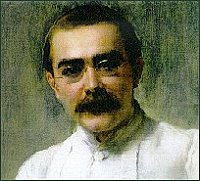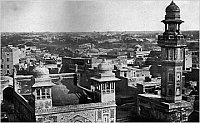Readme
Kipling's Narrator: Beyond the Pale of Decent Society
Tess Caiter

Shortly after his twenty-second birthday, Rudyard Kipling (1865-1936) published the short stories that he had written between 1886 and 1887 as journalist for the Civil and Military Gazette in Lahore (then British India, now Pakistan). They show Kipling as "an innovator and virtuoso"1 of the short story, to which he added complexity of method and depth of topic. He called this collection ironically Plain Tales from the Hills (Calcutta, 1888), alluding to Simla, the fashionable Hill resort at which the imperial British government of India resided during the hot summer months. Indeed, many stories in the collection take place at Simla or at similar stations (such as Darjeeling), and the title's amused, ironic and sometimes critical tone is repeated in the stories' look at customs and institutions of Anglo-Indian society. In contemporary critical evaluation, Kipling has come to bear much of the brunt of our Western collective guilt and reprisal for his open advocacy of Imperialism, which became more strident with increasing age. Plain Tales from the Hills, the author's first prose publication and a classic of Anglo-Indian literature, shows a more ambiguous perspective, however, than the one commonly attributed to him. A case in question is the stance of the third-person narrator of "Beyond the Pale," one of the best known and most contradictory of Kipling's stories.
The story tells of Trejago's brief and tragic illicit affair with a Hindu widow, the 15-year-old Bisesa, who lives in the house of Durga Charan, her uncle. Trejago, a British government official in Lahore, stumbles into the events (literally as well as metaphorically) due to his familiarity with "native life," as the omniscient narrator asserts from the very start:
| This is the story of a man who wilfully stepped beyond the safe limits of decent everyday society, and paid for it heavily. He knew too much in the first instance; and he saw too much in the second. He took too deep an interest in native life; but he will never do so again. (Kipling, 127) |
The dreamlike "double life so wild" (129) of their affair ends for Bisesa, when she hears of Trejago's paying "special attention to a lady of his acquaintance" - part of the "exigencies of his other life" the narrator asserts (130), but apparently irreconcilable with Bisesa's notions of a relationship.2 When next Trejago sees Bisesa, both her hands have been cut off at the wrist. Trejago himself is left with a permanent stiffness in his right leg when an unknown attacker wounds him at this last meeting.
The short story is scrupulously realistic3 by inclusion of accurate details of the inner city of Lahore4, which sometimes have symbolic overtones,5 by the ample use of sociolect and dialect (Anglo-Indian jargon, including Hindi or Urdu terms), and by the depiction of social determiners and class conflicts. Trejago is silhouetted6 against "native life" whereas his official, daytime pursuits remain vague and unspecified.
It also corresponds to Charles May's definition of a short story7 by centring on the individual world of Trejago, as opposed to his social world and manners, by the pronounced dream-like quality of the events (129) as well as the nightmare-like crisis which leaves a great many unanswered questions:
| There was a young moon, and one stream of light fell down into Amir Nath's Gully, and struck the grating which was drawn away as he knocked. From the black dark Bisesa held out her arms into the moonlight. Both hands had been cut off at the wrists, and the stumps were nearly healed. Then, as Bisesa bowed her head between her arms and sobbed, some one in the room grunted like a wild beast, and something sharp - knife, sword, or spear - thrust at Trejago in his boorka. The stroke missed his body, but cut into one of the muscles of his groin, and he limped slightly from the wound for the rest of his days. The grating went into its place. There was no sign whatever from inside the house, - nothing but the moonlight strip on the high wall, and the blackness of Amir Nath's Gully behind. The next thing Trejago remembers, after raging and shouting like a madman between those pitiless walls, is that he found himself near the river as the dawn was breaking, threw away his boorka and went home bareheaded. (131/132) |
Who draws the grating away? Why did Bisesa's hands get cut off? And when? And by whom? Is the grunt a warning? An expression of "Oriental innate bestiality"? What gets thrust at Trejago? Why is the grating replaced? Why does nobody react to Trejago's rage and shouting, why does nobody interfere - if only to finish Trejago off? To the very end, the reader cannot be sure of anything. Not even if it really was Durga Charan, Bisesa's uncle, who attacked Trejago.
Irritatingly (to modern readers) but historically accurate, race determines class in the Anglo-Indian world and an "apparently omniscient, even smug narrator"8 drives this point home.
| A man should, whatever happens, keep to his own caste, race and breed. Let the White go to the White and the Black to the Black. Then, whatever trouble falls is in the ordinary course of things - neither sudden, alien nor unexpected. (Kipling, 127) |
Yet the story, as the previously quoted passage shows, goes beyond depicting the tragic ending of a mixed-racial relationship which must needs succumb to the demands of social propriety and/or necessity (a well-established topic of Anglo-Indian literature in general). It shows instead a tragedy originating in the ultimate opaqueness of other cultures, a tragedy in the face of which the former "smugness" of the narrator vanishes. Describing the crisis in Amir Nath's Gully, the narrator's former omniscience is reduced to Trejago's necessarily fragmented grasp of the situation (viz. "some one," "something" etc.). Colonial reality remains inexplicable, inscrutable, like the silent "pitiless walls" against which Trejago rages uselessly.
Comparison between people in different cultural contexts is feasible to the narrator as human nature is similar9 - but there are limits. Ultimately, no full and lasting understanding is possible.10 This might be read as corresponding to the stereotype of the dangerous, unfathomable native and as ensuring the morale of "East is East and West is West and never the twain shall meet," no doubt Kipling's most famous quote yet,11 that the story's beginning so neatly prefigures ("Let the White go to the White and the Black to the Black...").
The story indeed abounds in negative evaluations by the narrator. The moral degradation supposedly affecting the white partner in a mixed-racial relationship according to prevalent Anglo-Indian literary and social prejudice finds its apt expression in the disguise Trejago regularly dons for his rendezvous, "the evil-smelling boorka."(130) The boorka serves as symbol of "his madness" (130), "this folly" (130) and "all the rubbish" (129) of Trejago's love for Bisesa from which his head needs to be and will be freed. A clear-cut case of racist Imperialism …were it not for the fact that the narrator of "Beyond the Pale" repeatedly and clearly extends his criticism to Trejago.
Most positive evaluations of Bisesa are attributable to the narrator channelling Trejago's perspective, and consequently echo Orientalist stereotypes of "roseleaf hands" (130) and "little feet, light as marigold flowers, that could lie in the palm of a man's one hand." (131) They focus on Bisesa as eroticised "child," exotic, "amusing," and "ignorant as a bird." (130) And they contrast heavily with the narrator's description of Bisesa as an experienced, frustrated woman,12 who initiates the affair with Trejago by sending an object letter, "an innocent, unintelligible lover's epistle" (128, note the narrator's irony) and by having the heavy grating of her window detached from the wall "so that the window slid inside, leaving only a square of raw masonry into which an active man might climb." (Kipling, 129) Whatever the clichés projected by Trejago onto Bisesa, the narrator knows and tells different.
Trejago's freedom of movement in society contrasts during the short story with Bisesa's complete enclosure in Durga Charan's house. Yet it is Trejago's inner confinement to the "Western standpoint" that precipitates the crisis in their relationship (Kipling, 131), and it is his persistence in not taking Bisesa seriously beyond Orientalist stereotypes that contrasts with Bisesa's awareness of Trejago's actions. In the course of the story, Trejago emerges as the more confined character of the two.
While Trejago never understands Bisesa's social background for the simple reason that he never enquires after it or shows any interest in it,13 Bisesa knows of his official life in all its social aspects. Having seen him in Amir Nath's Gully the previous night, she identifies him enough to have her object letter delivered correctly "as he was driving to office […] into his dogcart" (Kipling, 128) already on the very next morning. Similarly, the attentions he pays to the nameless Memsahib are reported back to Bisesa, because, the narrator cynically asserts "you may take it for a fact that anything of this kind is not only noticed and discussed by a man's own race, but by some hundred and fifty natives as well." (Kipling, 130)
It does therefore not come as a surprise to see that Bisesa's seeming conversion to an imperialist viewpoint in her rejection of Trejago's flirtatiousness is openly contradicted by the narrator.
| 'I know only this - it is not good that I should have made you dearer than my own heart to me, Sahib. You are an Englishman. I am only a black girl' - she was fairer than bargold in the Mint,- 'and the widow of a black man.' (Kipling, 131; emphasis added) |
It is thus not the up-front message of race and caste that matters at this point. Instead, in a generally ignored surprising aside, the narrator asserts that the two victims of the affair's tragic ending are Bisesa and - Durga Charan.14 The sympathy accorded to Charan as another victim of Trejago's racial transgression is striking, particularly when compared to the fact that Trejago himself is described critically and ironically throughout. His love for Bisesa is pronounced "true" explicitly by the narrator,15 yet his pursuit of this love finds no sympathy whatsoever. Such narrative irony extends to Anglo-Indian "decent society," which demands the lie of a "riding-strain" (Kipling, 132) to explain away Trejago's limp.

Added to this detachment from Trejago and his English prejudice is the narrator's knowledgeable position. He describes the exact situation of Charan's house in the labyrinthine inner city of Lahore; he comments ironically on the "Vernacular" rendition of "The Love Song of Har Dyal" from the Arabian Nights (quoted in English in the short story); and he deciphers the meaning of Bisesa's object letter to the readers in detail. In short, the narrator demonstrates all the knowledge he so eloquently condemns in Trejago. Or does he?
| Trejago knew far too much about these things, as I have said. No Englishman should be able to translate object-letters. But Trejago spread all the trifles on the lid of his office-box and began to puzzle them out. A broken glass-bangle stands for a Hindu widow all India over; because, when her husband dies, a woman's bracelets are broken on her wrists. Trejago saw the meaning of the little bit of glass. The flower of the dhak means diversely 'desire,' 'come,' 'write,' or 'danger,' according to the other things with it. One cardamom means 'jealousy'; but when any article is duplicated in an object-letter, it loses its symbolic meaning and stand merely for one of a number indicating time, or, if incense, curds, or saffron be sent also, place. The message ran then - 'A widow - dhak flower and bhusa -, at eleven o'clock.' The pinch of bhusa enlightened Trejago. He saw - this kind of letter leaves much to instinctive knowledge - that the bhusa referred to the big heap of cattle-food over which he had fallen in Amir Nath's Gully, and that the message must come from the person behind the grating; she being a widow. (Kipling, 128) |
One should think this is about as obvious as it can get. If the narrator did not elaborate and explain the meanings of the object letter that Trejago instinctively sees and knows, the readers would be left guessing. However, the demonstrative intimacy of the narrator with the intricacies of native culture is a sham. The object letter is copied in all details (down to the exact number of cardamoms) from Andrew Lang's classic Anglo-Indian novel Will He Marry Her? (1851).16 Significantly, too, the comments on the "Vernacular" version of the Arabian Nights quote are deprecatingly ironic: "The song is really pretty in the Vernacular. In English you miss the wail of it" (Kipling, 129). Despite all equivocal tendencies the narrator seems to firmly side in his evaluations with the Anglo-Indian context after all, which leaves him safe to sympathise with Bisesa as well as criticise Trejago. Apparent irreverence in the narrator then only veils a "deeper commitment to the program of the authorities."17 Or does it?
Readers who have arrived at such a conclusion with the ending of the short story have to face the narrator's last words. They present yet another full-fledged turnaround.
| But Trejago pays his calls regularly, and is reckoned a very decent sort of man. There is nothing peculiar about him, except a slight stiffness, caused by a riding-strain, in the right leg. (Kipling, 132) |
The final paragraph ironically exposes the social hypocrisy of Anglo-Indian society. Fittingly, Trejago the flirt and hypocrite is reckoned "very decent" by "decent society," who demands a hypocritical explanation for his limp but would ostracise him for his past experiences. The "riding-strain" reduces the complexities of the story to a level no reader can be expected to follow uncritically at this point. Causality itself is thus revealed as a social construct and the fabric of a socially agreed-upon ethic is stretched thin indeed. Ultimately, the question remains: Is it (im)possible to return to "decent everyday society" once we have followed the narrator beyond the pale?
Notes
- Andrew Rutherford, "Introduction," Rudyard Kipling, Plain Tales from the Hills (Oxford: Oxford University Press, 1986). All subsequent quotes of the Kipling text taken from this edition.
- "A week later Bisesa taxed Trejago with the flirtation. She understood no gradations and spoke openly. [...] Bisesa raged and stormed, and finally threatened to kill herself if Trejago did not at once drop the alien Memsahib who had come between them." (Kipling, 130)
- cf. Walter Greiner, Gerhard Stilz (eds.), Naturalismus in England 1889-1920 (Darmstadt: Wiss. Buchgesellschaft, 1983).
- "Deep away in the heart of the City, behind Jitha Megji's bustee, lies Amir Nath's Gully, which ends in a dead-wall pierced by one grated window. At the head of the Gully is a big cowbyre, and the walls on either side of the Gully are without windows." (Kipling, 127)
- "Her room looked out through the grated window into the narrow dark Gully where the sun never came and the buffaloes wallowed in the blue slime." (Kipling, 127)
- Silhouetting is defined by Marshall Brown, "The Logic of Realism: A Hegelian Approach," PMLA 96.2 (March 1981): 224-241, particularly 233.
- Charles E. May, " The Nature of Knowledge in Short Fiction," Studies in Short Fiction 21 (1984): 328.
- B. J. Moore-Gilbert, Kipling and "Orientalism" (London: Croom Helm, 1986) 179.
- "[…] then, kneeling before Trejago, [Bisesa] asked him, exactly as an Englishwoman would do, if he were sure he loved her." (Kipling, 130)
- "Trejago cannot tell. He cannot get Bisesa - poor little Bisesa - back again. He has lost her in the City where each man's house is as guarded and as unknowable as the grave; and the grating that opens into Amir Nath's Gully has been walled up." (Kiplin, 132)
- "The Ballad of East and West," Barrack Room Ballads and Other Verses (1891).
- "She was a widow, about fifteen years old, and she prayed the Gods, day and night, to send her a lover; for she did not approve of living alone." (Kipling, 127)
- "Who or what Durga Charan was, Trejago never inquired; and why in the world he was not discovered and knifed never occurred to him till his madness was over, and Bisesa… But this comes later." (Kipling, 130)
- "Neither Suchet Singh nor Gaur Chand approve of their women-folk looking into the world. If Durga Charan had been of their opinion he would have been a happier man to-day, and little Bisesa would have been able to knead her own bread." (Kipling, 127)
- "Trejago swore that he loved her more than any one else in the world. Which was true." (Kipling, 130)
- Moore-Gilbert, 24.
- John A. McClure, Kipling and Conrad: The Colonial Fiction (Cambridge, Mass.: Harvard University Press, 1981) 48.
References
Kipling, Rudyard. Plain Tales from the Hills. Oxford: Oxford University Press, 1986.
Brown, Marshall. "The Logic of Realism: A Hegelian Approach." PMLA 96.2 (March 1981): 224-241.
Greiner, Walter und Gerhard Stilz (eds.). Naturalismus in England 1889-1920. Darmstadt: Wiss. Buchgesellschaft, 1983.
McClure, John A.. Kipling and Conrad: The Colonial Fiction. Cambridge, Mass.: Harvard University Press, 1981.
May, Charles E.. " The Nature of Knowledge in Short Fiction." Studies in Short Fiction 21 (1984): 327-338.
Moore-Gilbert, B. J.. Kipling and "Orientalism." London: Croom Helm, 1986.
Illustrations
Rudyard Kipling
City view of Lahore, photograph Samuel Bourne, October 1864.
Further Links
"Victorian and Pre-Victorian Colonial India," The Victorian Web : Literature, History and Culture in the Age of Victoria.
including a short biography of Kipling
The Kipling Society with the full online text of some short stories from Plain Tales from the Hills
Complete Poems of Kipling




